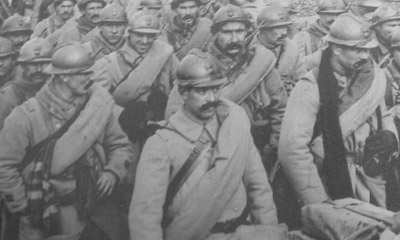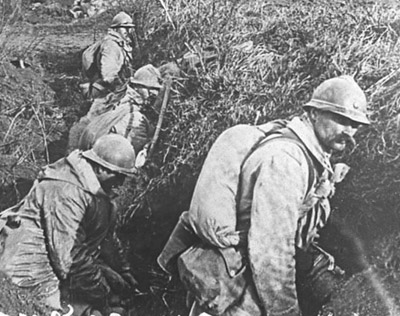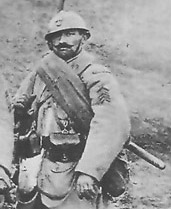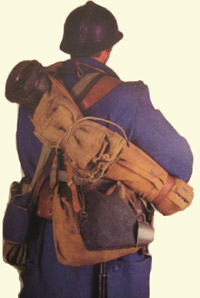Assault Order (Assembly of Assault Roll)
Later in the war, infantrymen taking part in an assault were sometimes allowed to leave their knapsacks in the support trenches for what were deemed "limited operations." This implied offensive combat operations of limited scope, from a small-unit raid to a larger-scale (battalion) attack. In its stead, they would wear a rouleau d'assaut ("assault roll"), also referred to as tenue d'assaut ("assault order"). The purpose was to give the infantrymen a greater amount of speed and flexibility in an attack.
In his work Verdun Georges Blond gave a description for the kit they carried with them for the attack on Douaumont on 21 October 1916:
"[T]he soldiers of the 321 RI carried in addition to their equipment and cartridge pouches: two gas masks, one haversack with hardtack, another containing beef and chocolate, a third with grenades, one two-liter canteen with wine, another for water, the blanket rolled in the tent-canvas, a spade-shovel entrenching tool, two sandbags."
According to the 1918 edition of the Manuel du Chef de Section d'Infanterie ("The Manual of the Infantry Platoon Leader"), the tenue d'assaut consisted of the following:
Clothing: field dress without pack
Equipment:
Ammunition: 120 rounds in cartridge pouches.
Rations:
*Another combination consists of taking the pack for carrying the rations, tent-canvas, and the blanket. Also note, if the weather is particularly rainy, it is useless to bring along the blanket.

Assembly of Assault Roll
The assault roll centers around the tent-canvas. The tent-canvas was first rolled or folded up with the blanket inside. If rolling, this should be rolled tightly. If folding, the width should be about 5-6". A broad shoulder roll should be avoided. In either case, the blanket should be made to fit within the edges of the tent-canvas and should not extend past the edges. Once done, the shoulder roll was then folded in two (without twisting the roll) to make a horseshoe. The two ends of the tent-canvas were then either tied together or were bound together using the short cross-strap supplied with the backpack (twine can be used if no strap is available).

An alternate method for assembly involved rolling the blanket into a short roll first, placing it in a corner of the tent-canvas and rolling it up across the diagonal. The empty ends of the tent-canvas should then be tightly twisted and then tied together.

The roll was worn slung over one shoulder, across the chest. For formations and marching, it was to be worn over left shoulder while for operations it was up to the soldier's discretion. The soldier's e-tool could also be strapped on (normally on the back side), along with sandbags (2-5), allowing the soldier to entrench and fortify newly-gained positions. Sometimes the mess-tin would also be carried, either wrapped up inside or strapped onto the outside of the roll with the soldiers rations stowed inside.









